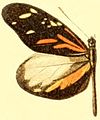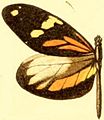| Tiger mimic white | |
|---|---|
 | |
| Scientific classification | |
| Domain: | Eukaryota |
| Kingdom: | Animalia |
| Phylum: | Arthropoda |
| Class: | Insecta |
| Order: | Lepidoptera |
| Family: | Pieridae |
| Genus: | Dismorphia |
| Species: | D. amphione |
| Binomial name | |
| Dismorphia amphione | |
| Synonyms | |
List
| |
Dismorphia amphione, the tiger mimic white, is a species of butterfly of the family Pieridae. It is found from Mexico and the Caribbean down to Brazil and Bolivia.
Contents
The wingspan is about 77 mm. It is an extremely variable species. [2]
The larvae feed on Inga species, including I. sapindoides and I. densiflora .
Dismorphia amphione mimics the ithomiine butterflies of the genus Mechanitis ( M. lysimnia , M. polymnia , M. mazaeus , M. menapis ) in colour pattern and in the slow regular flight. [3]







